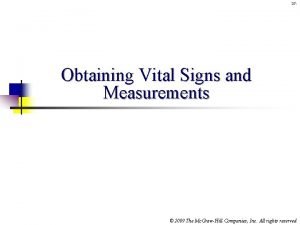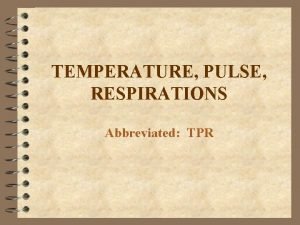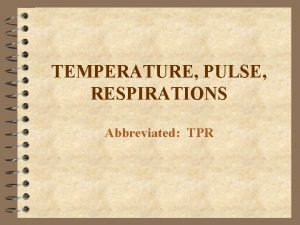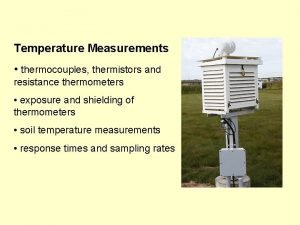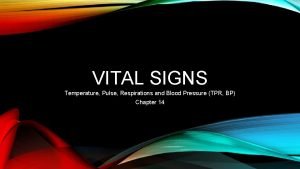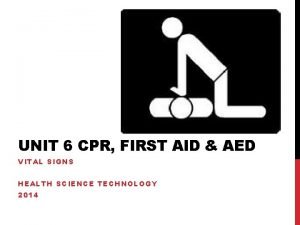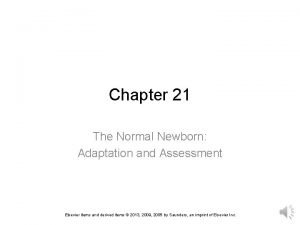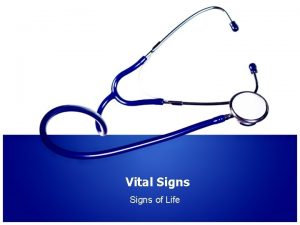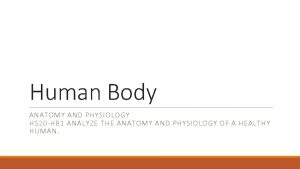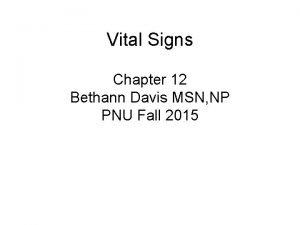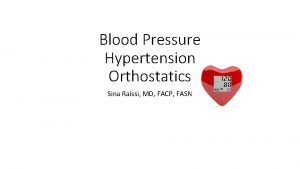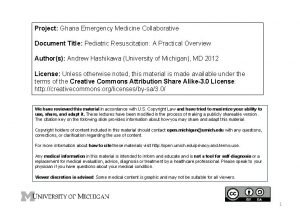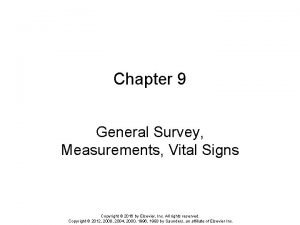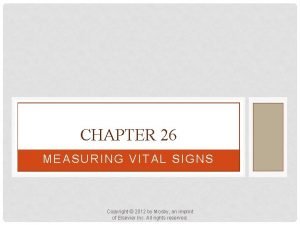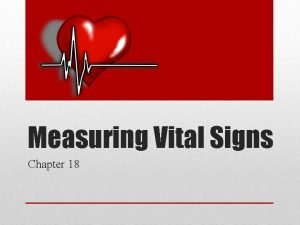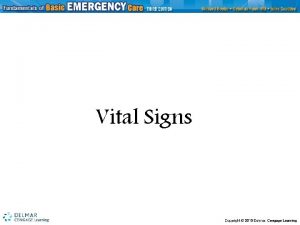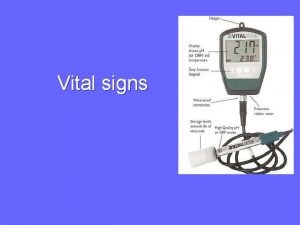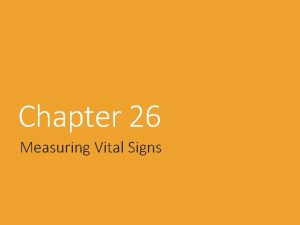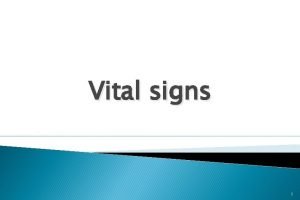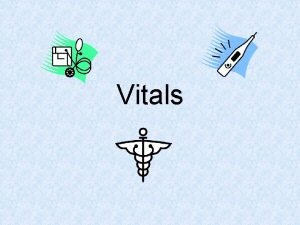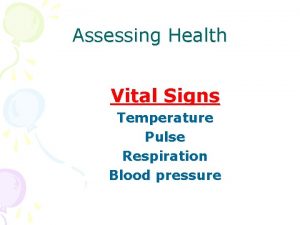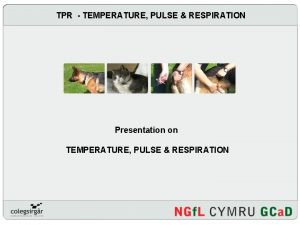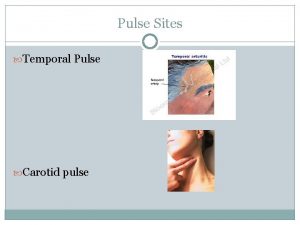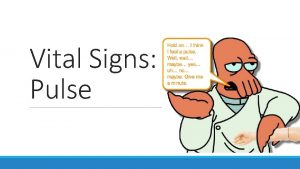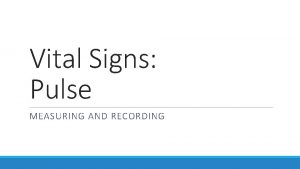Temperature Pulse Respiration Vital signs are measurements of





























- Slides: 29

Temperature, Pulse, & Respiration

Vital signs are measurements of the body's most basic functions. The three main vital signs routinely monitored by healthcare providers include body temperature, pulse rate and respiration rate.

Vital signs include Temperature Pulse Respiration Blood Pressure

Temperature Refers to temperature inside the body or core body heat Can be measured by four basic routes 1. Oral 2. Rectal 3. Axillary 4. Tympanic Several types of thermometers Electronic/Digital Glass Thermoscan for Tympanic measurement

Normal temperature ranges Oral 97. 6 degrees F. – 99. 6 degrees F Axillary 96. 6 degrees F. – 98. 6 degrees F. Rectal 98. 6 degrees F. – 100. 6 degrees F.

Tympanic: Manufacturer’s guidelines suggest that the measurement is the same as rectal temperatures. Axillary is one degree Fahrenheit lower than Oral Rectal is one degree Fahrenheit higher than Oral

Reading temperatures By degree and tenth of a degree Place thermometer at eye level and look for silver line of mercury Never place fingers on bulb of thermometer as this might change the value

Thermometers and routes Probes for electronic and mercury-free ends are color coded for route. Red If = rectal; Blue = oral/axillary no color present, the route will be written on thermometer

Measurement of temperature Use protective cover on each thermometer Tympanic probe placed in ear Rectal thermometer or probe placed in rectum one inch with lubrication applied before insertion. Oral thermometer placed in mouth under the tongue

Do not take oral temperatures on preschool children patients with oxygen delirious, confused, disoriented patients comatose patients with nasogastric tubes in place patients who have had oral surgery patients who are vomiting or are quite nauseated

Do not take rectal temperatures on infants or children unless a core temperature is needed patients who have had rectal surgery combative patients

Duration of taking temperature Tympanic – a couple of seconds – long enough to gently press a button. Oral and rectal (glass thermometer) – three minutes. Axillary glass thermometer) – 10 minutes Electronic temperatures – when beep sounds, temperature is obtained

Abnormal temperatures Fever, febrile, hyperthermia all indicate someone who has an elevated temperature (greater than 100 degrees Fahrenheit). High fever would include anything over 103 degrees Fahrenheit. Moderate fever would include anything 100 – 103 degrees Fahrenheit. Hypothermia is subnormal temperature. This can be equally problematic for a person. Anything under 96 degrees Fahrenheit would indicate hypothermia.

Pulse Wave of blood produced by beating of heart and traveling along the artery Can feel at points where the artery is between finger tips and a bony area

These areas are called pulse points and include Temporal-side of forehead Carotid-at the neck Brachial-inner crease of elbow Radial-inner aspect of wrist Femoral-upper thigh Popliteal-behind the knee Dorsal Pedalis-top of foot arch

Measured by index, middle, and ring fingers over pulse point. Do not take with the thumb, since it has a pulse of its own. Count for 30 seconds and multiply by 2, or count for 60 seconds

Normal range is 60 – 100 beats per minute. The area of 90 -100 is a gray area in that a pulse should never constantly remain in this area. > than 100 = tachycardia < than 60 = bradycardia

Quality of pulse is determined as well as rate Rhythm – regular or irregular Strength – Bounding or thready

Circumstances affecting pulse rate Body temperature Emotions Activity level Health of heart Perfusion is the flow of blood throughout the body. Someone with sufficient perfusion has a strong enough heart beat to adequately oxygenate the body.

Respiration Each breath includes inspiration and expiration. Measure by observing chest rise and fall. Measured in breaths per minute.

Normal range = 12 -24 breaths per minute. > than 24 = tachypnea – if breathing in great depth then called hyperpnea < than 12 = bradypnea Difficulty in breathing is called dyspnea

Quality of breathing is determined as well as the rate of breathing Depth Clarity of breath sounds Pain with breathing Difficulty breathing – use of accessory muscles – sternocleidomastoid and intercostal muscles

Procedure for Taking TPR If using glass thermometer, insert thermometer. If axillary or rectal hold thermometer throughout the time. If oral, insert thermometer and proceed to take the pulse and respiration. If using electronic – take the temperature first, then proceed to the pulse and respiration.

Temperature When measuring axillary temperature, remove any clothing that could impede the accuracy of the temperature. Also clean the axilla if there is excessive deodorant or perspiration present. When measuring the rectal temperatures, always lubricate thermometer with water-soluble gel before inserting into the rectum. Never touch the bulb end of thermometer with the fingers.

Pulse and Respiration When taking the pulse and respiration, do not drop the wrist until both the pulse and respiration are taken. This way the person does not know when his/her respirations are being measured – insuring a more accurate measurement.

Charting Chart Do in order of TPR not write T =, P =, - simply 98. 6 – 84 – 22 Write (Ax) after axillary temperatures Write (R) after rectal temperatures

ABBREVIATIONS SOB - Short of breath TPR - Temperature, pulse, and respiration Within normal limits P. O. - By mouth BID -Twice a day TID -Three times a day QID - Four times a day QS - Every shift QD - Every day PRN - As needed Ad Lib - At liberty B/P - Blood Pressure VS - Vital Signs

TERMS Eupnea - Normal breathing Orthopnea - Sitting upright to breath more easily Apnea - No breath Hyperpnea - Fast, deep breathing Tachypnea - Fast, shallow breathing Bradypnea - Slow breathing Dyspnea - Painful or difficult breathing Tachycardia - Pulse rate in excess of 100 bpm Bradycardia - pulse rate less than 60 bpm

TERMS Bounding pulse excessively strong pulse Thready pulse - Pulse rate difficult to palpate because the heart is not beating hard enough to produce a strong wave of blood. Feels as though there is a piece of thread running under the fingertips.
 Vital signs temperature pulse respiration worksheet
Vital signs temperature pulse respiration worksheet Sign chapter 37
Sign chapter 37 Vital signs normal values
Vital signs normal values Vital signs and anthropometric measurements:
Vital signs and anthropometric measurements: Temperature is an anthropometric measurement
Temperature is an anthropometric measurement Insidan region jh
Insidan region jh Temperature pulse respiration abbreviation
Temperature pulse respiration abbreviation Dorsal pedalis
Dorsal pedalis Signs signs everywhere signs meaning
Signs signs everywhere signs meaning External respiration vs internal respiration
External respiration vs internal respiration Internal respiration
Internal respiration Colour code detector
Colour code detector Where is the apical pulse located
Where is the apical pulse located Capacidad vital y capacidad vital forzada
Capacidad vital y capacidad vital forzada What are temperature pulse respirations and blood pressure
What are temperature pulse respirations and blood pressure Vital signs height and weight
Vital signs height and weight 6 vital signs first aid
6 vital signs first aid Chapter 21 the normal newborn adaptation and assessment
Chapter 21 the normal newborn adaptation and assessment Normal respiratory rate
Normal respiratory rate Vital signs normal range
Vital signs normal range Msn signs
Msn signs Tpr graphic sheet
Tpr graphic sheet Orthostatics definition
Orthostatics definition Vital signs normal values
Vital signs normal values 5 tanda vital sign
5 tanda vital sign Pulse strength scale
Pulse strength scale Chapter 26 measuring vital signs
Chapter 26 measuring vital signs What is positive orthostatics
What is positive orthostatics Finding the brachial pulse
Finding the brachial pulse Respiratory number 18
Respiratory number 18


